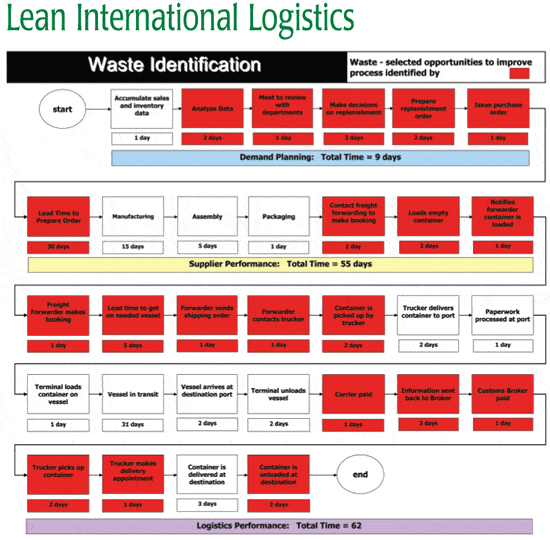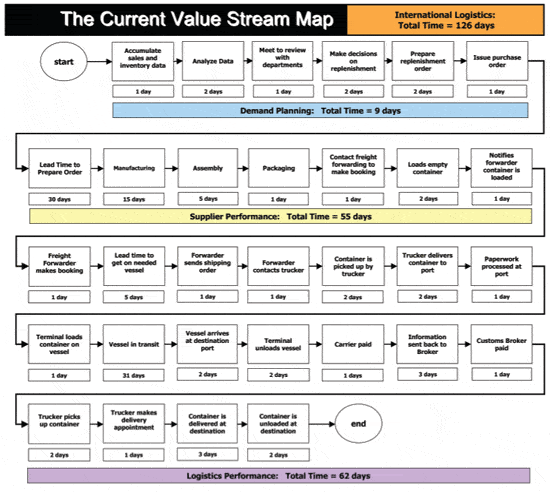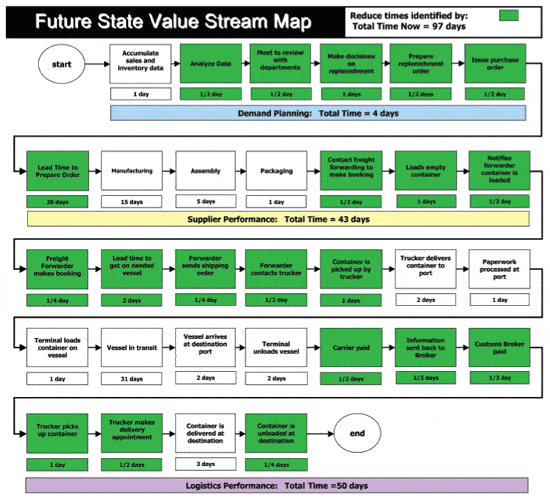Part 3: Lean International Logistics & Value Stream Mapping.
Editor’s note: You may, after reading this article ask yourself if implementing the process described below can benefit your operation. For most FURNITURE WORLD Magazine readers the answer is yes. Bigger firms will generate more in absolute dollars, but even smaller retailers can get excellent results. Lean benefits with compressed cycle time and increased inventory velocity can be had by any firm that is willing to take a serious look at what they do (from a sourcing and logistics standpoint) and how they do it.
Tom Craig notes that small and medium sized retailers may not have the in-house expertise needed to purchase and use specialized software (such as Log-Net). Instead, they can choose to work with focused supply chain 3PLs (third party logistics providers) or 4PLs (fourth party logistics service providers) on their imports to gain many of the benefits discussed in this article. Some large 3PLs may not give much attention to SMEs (small and medium sized enterprises), so if pursuing this option, care should be taken to use a firm that focuses on managing the import supply chains of SMEs. A third option is to bring in an impartial consultant with real world experience.
For furniture retailers Lean logistics is about flow and the elimination of waste. Waste can be defined as anything that does not add value to the product, that is, anything that the customer would not be willing to pay for. Waste in logistics can be defined in terms of unnecessary activities that result in excess inventories, increased lead-time and increased cost.
To date, much of the focus of lean logistics has been on manufacturing in domestic markets. However, the logistics industry is changing at a rapid pace. We now face global supply chains that challenge us with a complex network of suppliers and logistics service providers. From China to India and throughout the world, lead times have been significantly extended. This certainly makes us wonder if these changes to global supply bases have received the deserved share of attention from lean practitioners.
There are three key segments to global supply chain management:
- Demand planning and management.
- Supplier performance and management.
- Logistics service providers (both internal and external) performance and management.
Value stream mapping presents a visual way to describe the current condition of a supply chain. The value stream comprises all the steps necessary to bring a product from raw materials through production to delivery to the customer. With value stream mapping, all the steps in the supply chain process are identified and assessed as to whether they add value or create waste. Typically, there are two streams or flows to be described and analyzed. These include the flow of product and the flow of information.
This works well with the “pull” or Kanban basic approach to supply chain management. Inventory is pulled, not pushed, through the supply chain from customer back through to suppliers. With the pull, excess inventory should be removed from the supply chain.

Mapping is a tool to visualize what goes on. The picture is a way to see the non-value, waste creating actions for both the product and information flows. There should be integration between the two flows. Otherwise opportunities for non-value added activities and for inconsistent actions are created.
Value stream mapping looks at a key product(s) that have high volume and/or high profit margins. The logistics process for each product is mapped, analyzed, waste is identified and a new process for the future is defined and implemented.
The mapping involves gathering customer or store information, depending on whether you are a wholesaler/distributor, manufacturer or retailer. Draw the process—from what triggers the purchase order back through the suppliers and logistics providers to delivery.
Since there can be 15 or more parties involved in the movement of product and information and taking into consideration both the product and financial chains, the supply chain can be complex to visualize. Collaboration and cooperation are, therefore, needed among all the parties involved for proper mapping and to identify waste. Every participant, even, for example, a supplier in Shanghai whose key component comes from Thailand must be active in the mapping.

Even a customs broker who does not directly touch the product or the shipping container needs to be involved. He acts using the information and documentation to facilitate product movement. The linkage among the importer, customs broker, ocean carrier/air forwarder and delivering rail or trucker can create waste that results in delays and the cessation of product flow.
Value stream mapping creates a picture of the supply chain process or what passes for a process in a retail supply chain. Retailers who have not made efforts to adequately manage their supply chain find that this lack of attention creates waste, or non-value added activity. Global supply chain waste occurs as unneeded cycle time, inventory and cost. The cost of waste often shows up in transportation and warehousing activities.
A company with no viable global supply chain process often has gaps in the "process" activities. In turn, there are redundancies at various points to compensate for these gaps. These redundancies cause extra, unnecessary work that can be visualized as islands of waste in the flow. Expediting is an example of a waste that can arise because of flaws and gaps in a process.
Lean international supply chain management is made more complex by the fact that so much activity occurs outside of the company. With lean manufacturing and domestic lean logistics, much of the activity occurs within the company.
It is not uncommon for company people involved in global supply chain activities to push much of the waste they cause through their own actions onto outside parties. This forces outside suppliers to adjust but does not solve underlying problems or create a more efficient supply chain. True progress must be a collaborative process -- a two-way effort to reduce waste.
See where the process is being forced to fit your company or some other entity and, as a result, creates significant waste. Clear analysis is needed to design the new process. Thinking beyond traditional logistics is needed. Otherwise one flawed process can replace another flawed process.
The import supply chain must be seen as one event, not as two separate events of sourcing and of logistics. The dichotomy can show on both the product map and the information map. This affects the handoff from supplier to logistics service providers. Assessing modes, carriers/forwarders, service and ports/airports can reduce time for key products.

In our industry, over twenty-five percent of purchase orders are not shipped as planned or are not delivered as planned. This significant statistic presents a real opportunity to reduce waste. Supplier performance and supplier lead times are important areas for potential waste reduction and process improvement.
Also, your distribution network may be outdated. It may have been built years before with different store or customer configurations, different products, etc. It may have been built when the emphasis was on storing inventory in warehouses, unlike now when the emphasis should be on inventory velocity. Touching the product to store it often adds only time, a waste result, not value.
Bypassing warehouses with cross-dock or other transfer facilities at ports can remove time and inventory. Supply chain execution technology can give visibility from the purchase order through to delivery order. It can provide the way to allocate product in transit. Making this part of the new process reduces two key wastes—time and inventory.
Global supply chain management has significant "built-in" time because of the distances involved, so it differs from domestic supply chain management. The extended time can, in turn, create uncertainty and the need for many retail organizations to build and carry additional inventories. Time and inventory are two areas of waste that lean supply chain management can improve.
Identifying non-value added activities is especially important for worldwide supply chain management. Any activity that adds time, inventory and cost to already complex activities can compound supply chain inneficiencies. When you use value stream mapping to visualize and identify internal and external waste, plans can be made to improve your supply chain. This is especially critical for high volume and high margin products where the impact on the company bottom line is significant.
Collaboration and cooperation within the company organization and between and among trading partners is important to truly remove waste across the entire supply chain. Accelerating cycle time, increasing inventory velocity and reducing costs for the high volume and high margin products can have ROI impact and drive the benefit of lean for everyone to see.
This article was written by Tom Craig of LTD Management and Steve Gran of LeanCor. Tom has 25+ years experience in logistics, both international and domestic. His company LTD Management, is a logistics/supply chain management consulting firm working both domestically and internationally. The company leverages the buying power of its members for lower ocean freight rates. LTD Management also provides logistics/supply chain management consulting. He is the author of numerous articles on supply chain management. Questions can be directed to Tom at tomcraig@furninfo.com.